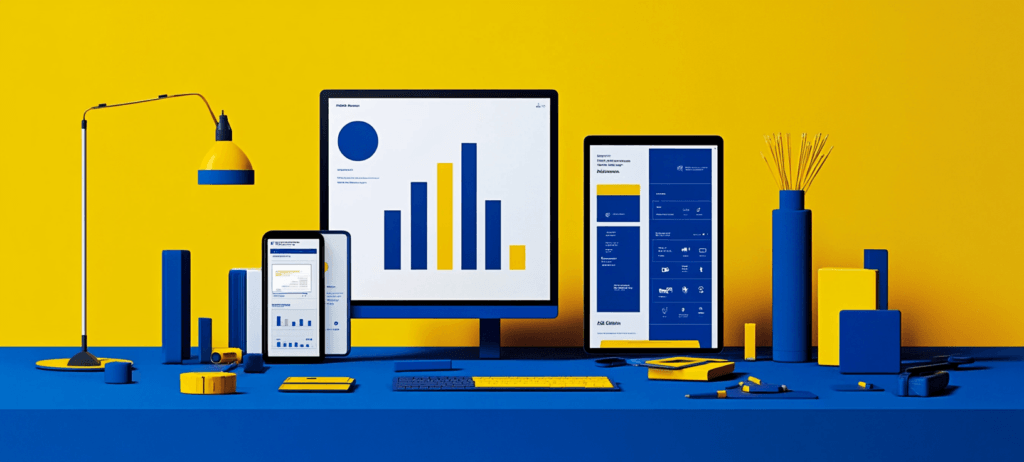-
 Published: May 5, 2025
Published: May 5, 2025
-
 7 min. read
7 min. read
-
Summarize in ChatGPT
-
 Sarah Berry
Sarah Berry Lead Web Marketing Consultant
Lead Web Marketing Consultant
- Sarah Berry is a Lead Web Marketing Consultant at one of the largest digital marketing agencies in the USA — WebFX. With more than 10,000 hours of experience, she offers practical insights and strategies to grow your digital revenue. Her work has been cited by Michigan State University, Business Insider, and Ars Technica. When she isn’t polishing her Time Magazine Person of the Year Award, she’s spending time with her flock of ducks.
Google does it. Bing does it. And now, ChatGPT does it. With ChatGPT Shopping, users can discover products in carousels similar to Google’s and Bing’s shopping results, giving businesses like yours a new outlet for generating revenue.
Discover the ins and outs of ChatGPT’s shopping results (including how to appear in them) now!
What is ChatGPT Shopping?
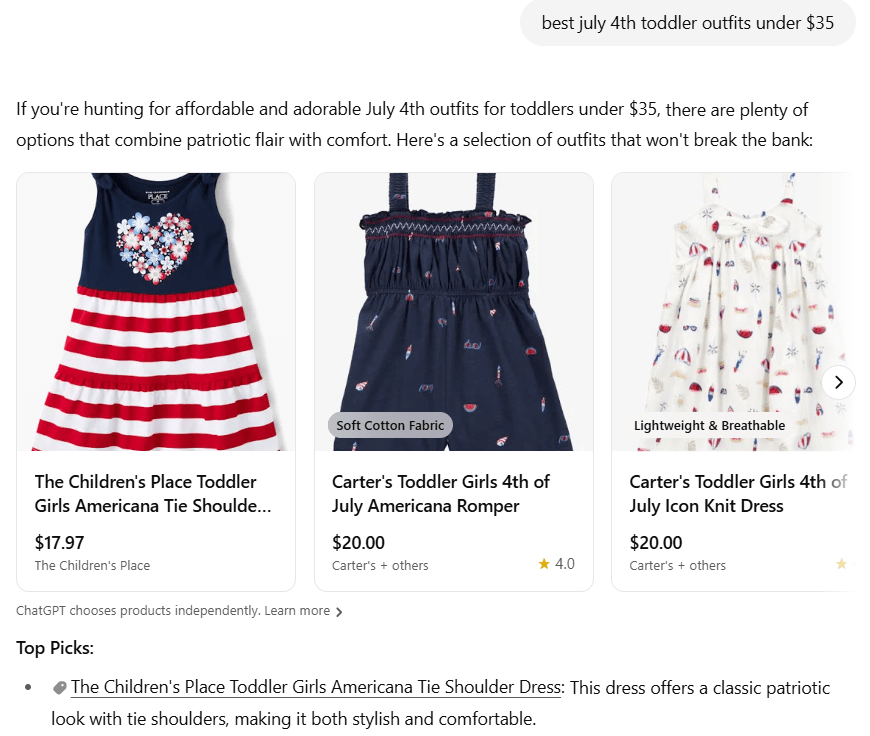
ChatGPT Shopping is OpenAI’s response to one of the most common use cases for the platform: Researching and buying products. With shopping results on ChatGPT, users see a visual carousel with relevant products and links to their product pages.
ChatGPT’s shopping carousels are not paid ads, though advertising is coming to ChatGPT.
How does ChatGPT Shopping work?
There are several components (or ranking factors) to ChatGPT’s shopping results, including:
| Factor | Function |
| User intent | Understand what the user wants and whether shopping results are relevant. |
| Personalization | Use memories and custom instructions to understand the user’s intent further. |
| AI model | ChatGPT uses its training data and then search data to generate its response. |
| Safety standards | Like other conversations, ChatGPT ensures the request aligns with its safety standards. |
| Structured metadata | Gets product information from structured data, like price, description, and reviews. |
| Labels | Categorizes products based on the model and third-party data, like “Budget-friendly” or “Most popular” |
| Review summaries | Summarizes likes, dislikes, average rating, and rating count using data from across websites. |
It’s important to note that ChatGPT does not rank product results based on:
- Price
- Shipping costs and policies
- Return policies
These factors can — however — determine whether a product gets recommended.
If a user’s search intent requests a product under a certain amount or a provider with XYZ shipping or return policies, then ChatGPT will search for products that meet those requirements. And that’s okay! You want qualified traffic vs. vanity visits to your site.
You can see how ChatGPT generates its shopping results in the example below:
| Search: “best July 4th toddler outfits under $35” | |
| FACTOR | DETAILS |
| User intent | The search specifies:
|
| Personalization | Based on memories, ChatGPT knows the user lives on the West Coast, where temperatures are higher during the given month. |
| AI model | N/A |
| Safety standards | The user’s search meets OpenAI’s safety standards. |
| Structured metadata | ChatGPT uses structured metadata to compile:
|
| Labels | The search generates labels like:
|
| Review summaries | ChatGPT does not generate a review summary in this example. |
Once the results generate, users can click on different listings to see:
- Additional product images
- Where they can purchase the item
- Why they might like the item
- What other people are saying about the item
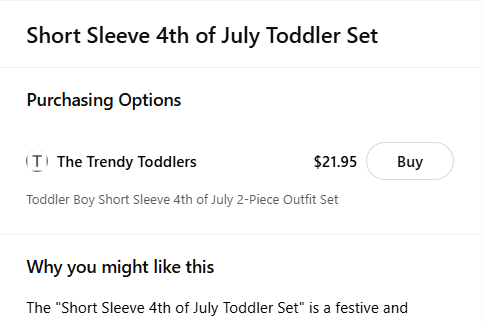
Users also have the option to select an item and ask ChatGPT for more details.
How does ChatGPT Shopping compare to Google and Bing?
So how do the product carousels compare for ChatGPT vs. Google? What about Bing? Compare all three below:
| Area | ChatGPT | Bing | |
| Price | Free | Paid | Paid |
| Product carousels | ✓ | ✓ | ✓ |
| Relevance | Customized to user intent and personalization | Requires filtering unless specified | Requires filtering unless specified |
| Structured metadata | ✓ | ✓ | ✓ |
| Labels | Customized to user intent and personalization | Limited to promotions, like “Sale” or “Free shipping” | Limited to discounts, like “25% off” |
| Review summaries | ✓ | Common phrases, like “Fits well” | None |
For a visual comparison, check out these examples for “best July 4th toddler outfits under $35”:
ChatGPT

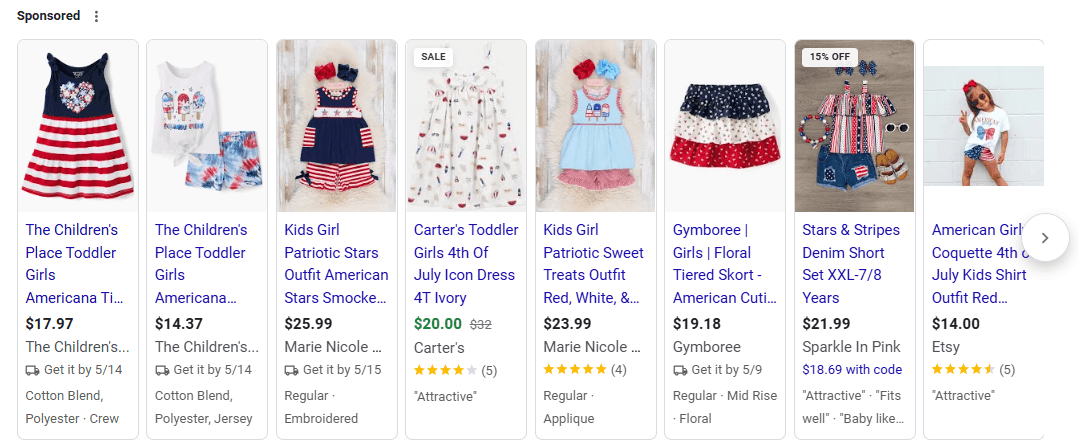
Bing
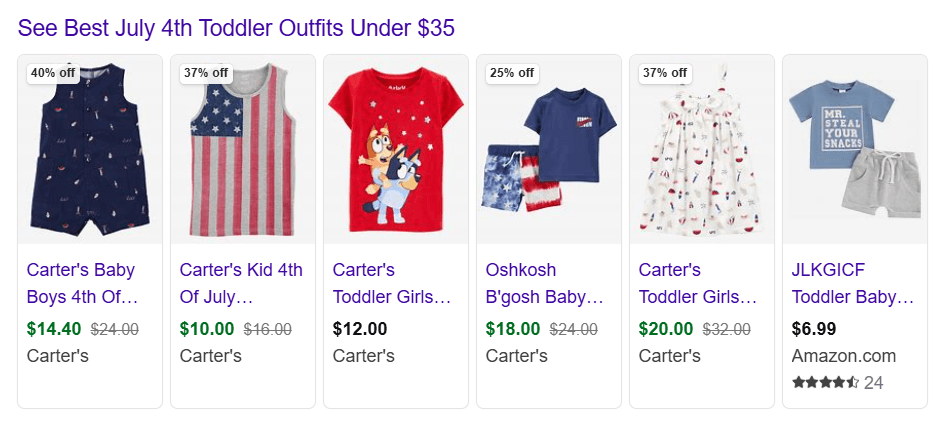
There are a few observations from these examples:
- One of the ChatGPT product listings also appears in Bing’s results
- Two of the ChatGPT product listings also appear in Google’s results
- The ChatGPT and Google product listings are all for girls, suggesting personalization
It’s no secret that ChatGPT’s third-party data providers include Bing and that its crawler, OAI-SearchBot, is indexing content from across the web, which explains some of these initial similarities.
Why does ChatGPT Shopping matter?
There are a few reasons ChatGPT Shopping matters to marketers and business owners:
- Cost: ChatGPT’s product carousels are not You don’t have to pay to get discovered.
- Reach: As the #1 AI chatbot, ChatGPT reaches more than 800 million people each week.
- Overlap: ChatGPT Shopping overlaps with ecommerce search engine optimization (SEO).
- Targeting: ChatGPT’s personalization makes it easier than ever to reach your market.
- Integrations: OpenAI and Shopify will soon allow users to buy without leaving ChatGPT.
With ChatGPT Instant Checkout, that experience goes a step further — enabling users to purchase products directly in chat through the Agentic Commerce Protocol (ACP).
Plus, optimizing for ChatGPT Shopping now — versus later — gives ecommerce stores like yours a first-mover advantage. These optimizations will also improve your visibility in other search and answer engines, like Google, Perplexity AI, and more.
How to appear in ChatGPT Shopping results
Now, let’s unwrap how to appear in ChatGPT Shopping results:
- Allow ChatGPT’s crawlers: First, make it possible for ChatGPT’s crawler (OAI-SearchBot) to crawl your site. This optimization usually requires no action unless your robots.txt file has disallowed OAI-SearchBot. If that’s the case, update your robots.txt file.
- Practice ecommerce SEO: Rank higher in search engine results — and increase your chances of appearing in ChatGPT responses — with ecommerce SEO optimizations, which include SEO copy for product pages, schema markup, site architecture, and more.
- Use Product schema markup: Structured metadata — which includes Product markup — is one of ChatGPT’s selection factors for its shopping results. Use the markup to provide ChatGPT with essential information, like pricing, product name, average rating, and more.
- Upload products to Google Merchant Center: Give ChatGPT even more data for its shopping results with Google Merchant Center, which also supports Google’s AI-powered features, like AI Overviews.
- Enhance product visuals: You have little time to capture a user’s attention in search results, whether on ChatGPT or Google. Make it count with high-quality visuals that show your product vs. hiding it in lifestyle shots.
- Improve review generation: Invest in review generation, like through automated email drip campaigns, to build the number (and quality) of reviews for your products, which can serve as a powerful trust signal for users shopping on answer engines like ChatGPT.
3+ bonus tips when optimizing for ChatGPT
Learn more about getting discovered in ChatGPT conversations, from product listings to citations:
- Create a generative AI channel in GA4: Track traffic from ChatGPT and other AI platforms, like Gemini, Microsoft Copilot, and Perplexity AI, with a custom channel group in Google Analytics 4. You can even use ChatGPT to generate the necessary regex!
- Earn conversational mentions with OmniSEO®: Use OmniSEO®, which blends search and answer engine optimization to get brands discovered across search and answer engines. OmniSEO® uses a mix of content marketing, SEO, outreach, and more to drive results.
- Plan to advertise on ChatGPT: When it comes to ChatGPT ads, it’s a matter of when — not if. Take advantage of the opportunity and maximize your real estate on the platform by allocating some ad spend for experimenting with ChatGPT ads.
- Produce top-of-the-funnel content: You don’t have to settle for appearing in bottom-of-the-funnel searches. Reach users sooner and cut out the competition by producing high-quality, top-of-the-funnel content that includes firsthand insights, data points, and more.
Get discovered across ChatGPT searches
From conversational mentions to product carousels, there are multiple options for ecommerce stores looking to grow their visibility and revenue from ChatGPT — and hundreds of experts at WebFX who can help.
Discover how our award-winning OmniSEO® services can help by contacting us online today!
-
 Sarah Berry is a Lead Web Marketing Consultant at one of the largest digital marketing agencies in the USA — WebFX. With more than 10,000 hours of experience, she offers practical insights and strategies to grow your digital revenue. Her work has been cited by Michigan State University, Business Insider, and Ars Technica. When she isn’t polishing her Time Magazine Person of the Year Award, she’s spending time with her flock of ducks.
Sarah Berry is a Lead Web Marketing Consultant at one of the largest digital marketing agencies in the USA — WebFX. With more than 10,000 hours of experience, she offers practical insights and strategies to grow your digital revenue. Her work has been cited by Michigan State University, Business Insider, and Ars Technica. When she isn’t polishing her Time Magazine Person of the Year Award, she’s spending time with her flock of ducks. -

WebFX is a full-service marketing agency with 1,100+ client reviews and a 4.9-star rating on Clutch! Find out how our expert team and revenue-accelerating tech can drive results for you! Learn more
Try our free Marketing Calculator
Craft a tailored online marketing strategy! Utilize our free Internet marketing calculator for a custom plan based on your location, reach, timeframe, and budget.
Plan Your Marketing Budget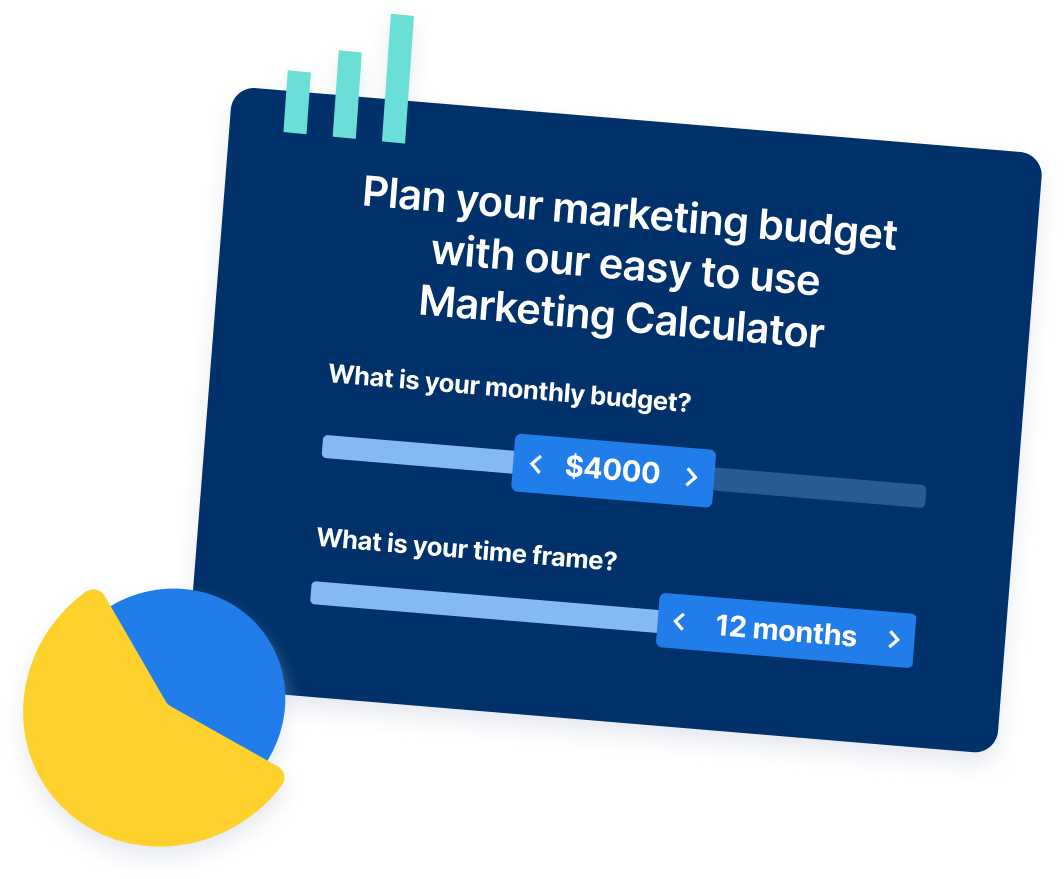

See AI Marketing in Action
Explore how WebFX helped a regional brand get discovered in AI search experiences — proving what’s possible with today’s AI-driven marketing!

Proven Marketing Strategies
Try our free Marketing Calculator
Craft a tailored online marketing strategy! Utilize our free Internet marketing calculator for a custom plan based on your location, reach, timeframe, and budget.
Plan Your Marketing Budget



